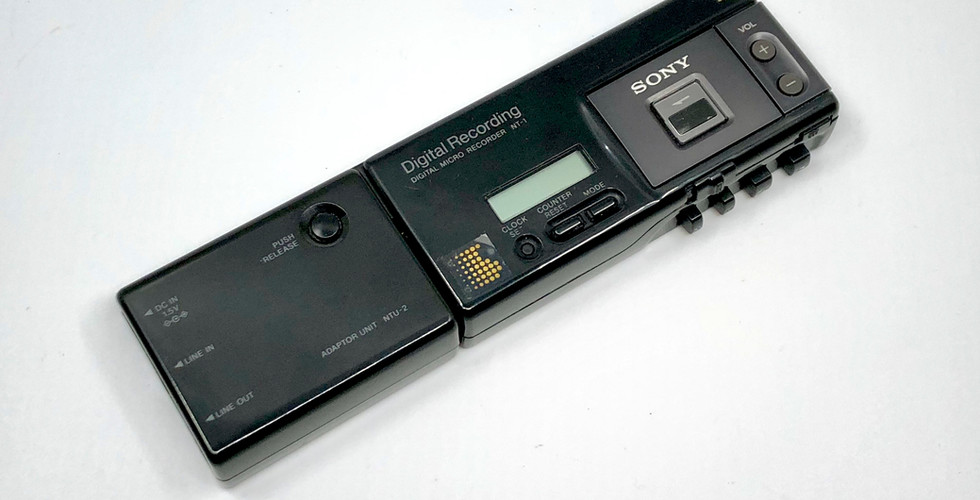Sony NT-1 Scoopman
- CK
- Dec 4, 2018
- 5 min read
Updated: Nov 5, 2019
We've often hear about Sony's Walkman, Discman and even Watchman but how many of you ever heard of Scoopman? Sony introduced a new digital memo recording system call NT, which stands for None-Tracking marketed under the name Scoopman in 1992. It is essentially a digital cassette tape recorder for journalists and law enforcement agencies. What's interesting about this is that Sony actually designed this with music enthusiast in mind. Its stereo audio sampling rate is 32 kHz 12 bit comparing that to CD's sampling rate of 44.1 kHz 16 bit, that's close to CD quality. Technical specifications aside, I've actually recorded some music from a HiRes source into NTC and it sounds amazing. To my ear, its sound has the clarity of CD and the warmth and smoothness of analog cassette minus the noise. I was quite impressed with the sound quality when I first listen to it. It is almost as good as DAT.
Feature:
• Digital stereo tape recorder: The non-track format of playback makes this compact size possible. Furthermore, high-fidelity digital sound is available with simple operations.
• Stamp-size cassette tape: The tiny NT cassette tape is capable of up to 120 minutes of playback/recording.
• Runs on one R6 (size AA) battery: One alkaline battery provides power for about 7 hours of continuous recording or about 6 hours of continuous playback.
• Auto Gain Control (AGC): The digital AGC adjust the recording level automatically and helps prevent recording mistakes. (The recording level can also be adjusted manually.)
• Clock with auto calendar function: The build-in clock/calendar records the date and time at the beginning of any recording. When you playback a recordin, you can see when it was made. The calendar records the date up to the year 2099.
Major Benefits:
• Pocket-able size
• Digital Hi-Fi stereo sound
• Long battery life with one R6 (size AA) battery
• Easy operation
How Can the NT Cassette Tape Be So Small?:
With the conventional helical scan system of tape tracking, during playback, the rotary heads must precisely trace each recorded track of the tape. This tracking method requires highly precise mechanical components, which made it difficult to reduce the size of the system. However, with the NT (Non-Tracking) format, the rotary heads are not required to precisely trace the recorded tracks during playback. Instead of tracking each track accurately, the rotary heads turn at a higher speed (twice as fast as that for recording) and reads more data. The data picked up may be disconnected or fragmented; however, the IC memory rearranges and augments the data and faithfully reproduces the original sound. Therefore, with this system, the number of mechanical parts could be reduced.

The NT-1 looks and operates pretty much like any Micro-cassette recorder. It has the usual play, pause, fast forward, rewind, stop, record, volume control as well as a few function buttons for setting the clock and recording mode. However, the NT-1 does not has built-in microphone nor it has Line-In. There's a Mic-In right next to the headphone jack where you can plug in an external microphone for recording. The Line-In and Line-Out can be achieved using the provided NTU-2 adapter.



The way the NTU-2 adapter connects to the NT-1 body is quite unusual. The AA battery has to be removed so that extended part of the adapter can slide into the battery compartment.


By the way, the digital cassettes used in the NT-1, NT-2 actually holds the world record of the smallest cassette tape in the world. Before you ask, yes it is much smaller than the micro-cassette tapes. It is about half the size of a micro-cassette tape but much thinner. It is actually closer to the size of an SD card.

To give you an idea how small it is, please take a look at the NTC right next to the other popular media formats.


But don't let the small size fool you. It comes in three different recording lengths, NTC-60, NTC-90 and NTC-120 which correspond to the recording time of 60, 90 and 120 minutes.

Just like any analog cassette player, the playing and recording head of the NT-1 requires cleaning. There's a cleaning cartridge for it too. Please make sure you don't use cotton swab with alcohol because it will damage the recording head.

This is an amazing music player and recorder. I had so much fun with it and enjoy the music coming out of it so much. It is quite rare and expensive because Sony only released two models this NT-1 and its predecessor the NT-2 in 1996 and it has ended its production long time ago. So, it is unlikely that you'll see one in person very often, meanwhile please enjoy the gallery. Thank you for reading.
NT-1 Specification:
• Format: NT format
• Tape: Digital micro tape (NT cassette tape)
• Recording system: Helical scan 2 heads, digital recording.
• Recording head: 3 heads
• Recording time: 90 minutes (supplied NTC-90)
• Tape speed: Approx. 6.35 mm/second.
• Drum rotation: 3000 rpm.
• Error correction: Cross-interleaving code.
• Track pitch: Approx. 9.8 um
• Sampling frequency: 32 kHz
• Modulation system: LDM-2
• Number of channels: 2-channel, stereo
• Quantization: 12-bit non-linear (equivalent to 17 bits)
• Frequency response: 10 Hz - 14,500 Hz (+1, -3dB)
• Signal-to-noise ratio: More than 80 dB (1 kHz, IHF-A, 20 kHz LPF, LINE IN)
• Dynamic range: More than 80 dB (1 kHz, IHF-A, 20 kHz LPF, LINE IN)
• Total harmonic distortion: Less than 0.08%
• Wow and flutter: Below measurable limit (less than 0.001%) W.PEAK)
• Tape Transport Mechanism Type: MN-1-66
• Material: Metal evaporated tape
• Maximum recording time: 12 minutes (double side)
• Mic Input:
• Jack type: Stereo mini-jack
• Rated input level: 1.38 mV
• Minimum input level: 0.55 mV
• Line In:
• Jack type: Stereo mini-jack
• Rated input level: 160 mV
• Minimum input level: 64 mV
• Power requirements:
• DC 1.5 V R6 (size AA) battery or AC power adaptor
• Battery life:
• Approx. 7 hours (consecutive recording)
• Approx. 6 hours (consecutive playback) (Sony alkaline battery AM3)
• Lithium battery life: Approx. 1 year.
• Power consumption: Approx. 300 mW
• Dimensions: 112.9x23.1x55.2 mm ( w/h/d) (4 1/2 x 15/16 x 2 1/4 inches) including projecting parts.
• Weight: 147g (5.2oz) (including battery)
Supplied accessories:
• Adapter unit NTU-2 (1)
• Lithium battery CR1220 (1)
• Sony alkaline battery AM3 (1, tourist model only)
• AC power adaptor (1)
• AC-E15L (230V) (AEP model)
• AC-NT1 (240V) (UK model)
• AC-NT1 (120V) (US, Canadian model)
• AC-NT1 (100-240V) (Tourist model only)
• AC plug adaptor (1, tourist model only)
• Connecting cord (pin-plug x2 ==> stereo mini-plug, stereo for line inputs and outputs) (2)
• Stereo microphone C-3001 (1)
• Microphone stand (1)
• Microphone attenuator NTU-3 (1)
• NT cassette tape NTC-90 (1)
• Stereo headphones MDR-E552 (1)
• Carrying case (1)
NT Cassette Tape Specification:
• Size: 30 x 21.5 x 5 mm (w x h x d) (1 3/16 x 1/8 x 7/32 inches)
• Weight: 2.3g (0.08oz)
• Width: 2.5 mm





















































































